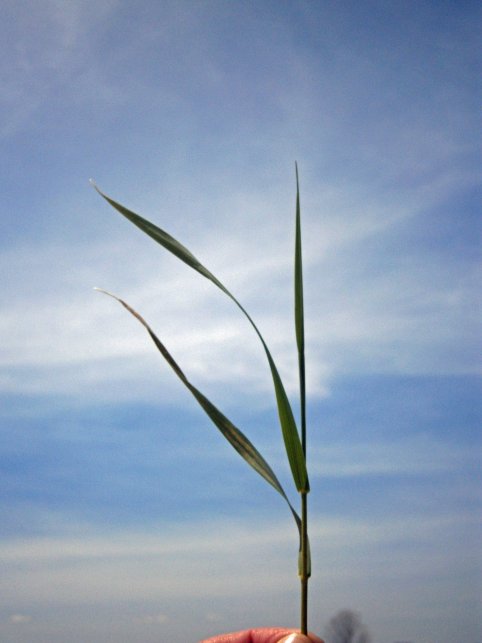
By Bethany Johnston, UNL Extension Educator
The last year has been difficult to manage for pasture health and production. First, the impact of the drought and hot temperatures in 2012 diminished plant health. This year, cool spring weather has slowed growth of cool-season plants. Combine that with below precipitation, and what is a grazing manager to do?
“We always turn out on May 15th.” Have you heard that before? Does a calendar date decide when the plant is ready to be grazed? Maybe a producer should consider the “leaf stage” instead.
The leaf stage of a plant can help a producer decide when the plant has enough leaf area to best tolerate grazing.
What is “leaf stage”? A simple definition is the number of leaves on a plant’s tiller or stem. If you pluck a stem at ground level, you can physically count the leaves. Count mature leaves, or leaves that are collared. Here is a picture of a grass plant: http://go.unl.edu/jod. As you can see, this grass is in the two-leaf stage, almost to the three-leaf stage. (The middle leaf is immature and has not formed a collar quite yet.)
Cool season grasses can be grazed in the spring, but need to develop 3 leaves before you graze. After the third-leaf stage, the plant has captured enough energy reserves to regrow after the plant has been defoliated. The plant’s stores are not quite built up at the two-leaf stage. Grazing at the two-leaf stage could weaken the plant.
Here is a picture of a 2 leaf stage: http://go.unl.edu/nxq
Here is a picture of a 3 leaf stage: http://go.unl.edu/35o
Remember, cool season grasses like warm days and cool nights. Cool season grasses start growing in the fall and another surge of growth occurs in the spring. Examples of cool season grasses are smooth brome, western wheatgrass, needleandthread, porcupine grass, and prairie junegrass. With the cooler than normal temperatures this spring, producers may need to delay turnout until their cool season grasses reach the third-leaf stage.
Warm season grasses grow well when the weather turns warmer (warm days and warm nights). These plants usually grow rapidly in the summer months of July and August.
To graze warm season grasses, wait until the grasses have reached a four-leaf stage. There should be four mature leafs coming off of one tiller or stem. Again, this allows the plants to regrow after grazing or defoliation events.
You should also know what the primary species in your pastures are. If you aren’t sure what plants you should be looking for, contact your local UNL Extension or NRCS Offices.
Utilizing leaf stages are just one way to help managers know when their pastures are ready to graze. Soil temperatures and moisture determine when a plant grows, not calendar dates!
More information can be found at “Grass Growth and Response to Grazing” http://www.ext.colostate.edu/pubs/natres/06108.html